Key Attractions
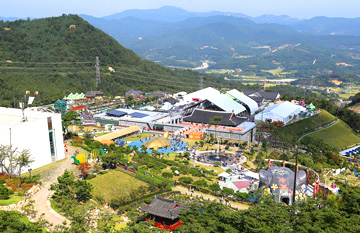
Sancheong is the hometown of Donguibogam and Jirisan Mountain. It is the birthplace of traditional medicine as it has become famous for excellent doctors such as Heo Jun, who was the greatest doctor of the time, and Chogaek and Chosam, whose reputation extended to China during the late Joseon period.
In addition, medicinal herbs, naturally growing at the foot of Jirisan Mountain, are widely known for their excellent efficacy. Sancheong-gun has inherited this tradition. Sancheong-gun has built Sancheong Oriental Medicine Museum in Teuk-ri, Geumseo-myeon and holds the Sancheong Medical Herb Festival every year in the museum. In addition, Donguibogam Village was created in order to make Sancheong the mecca of oriental medicinal herbs and oriental medicine.
Sancheong Oriental Medicine Theme Park is located in Donguibogam Village. The themes of this theme park are the Five Elements (Wood, Fire, Earth, Metal, and Water) that constitute creation. The theme park has been created in an environmentally friendly way including existing forest belts and valleys. Walkways have also prepared in order to provide places both for tourism and relaxation.
The first things that meet the eyes of the tourists when they bend their steps toward Sancheong Oriental Medicine Theme Park after they go sightseeing Korea's first specialized oriental medicine museum are sculptures symbolic of a bear and a tiger and Saemgol. The flood lamps and the decorated fences are harmonious and pleasurable to the eyes of the watchers. There is a pond called Chojeong Pond on the right side of the Symbol Street, and a sculpture of a girl who is drawing water from the pond in the middle of the pond. There is a walkway called Excellent Doctor Village right next to Saemgol. An acupressure trail is installed on this walkway, so it feels good to walk barefoot and get acupressure on this trail. The representative sculpture of Hanbanggol is the bear sculpture. It plays the role of an observatory. There are other attractions to appreciate such as Sipjangsaeng Park, the 12 Gods Fountain Square, and sculptures expressive of the inside of a human body among others. As there is also the Play Village in Sancheong Oriental Medicine Theme Park that children are sure to love. It is a good place to hang out on a family trip or spend time on a summer vacation.
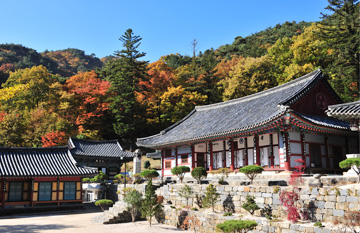
Daewonsa Temple is Korea's representative Zen Meditation area for Buddhist nuns. Daewonsa Temple was established by Yeongi Josa in 548. The temple is built in the form of a Mountainous-district-Temple.
The stairs create a mystical atmosphere as they lead to the Cheonwangmun Gate, as if a crane spread its wings in order to lead all human beings to a fairy land. Daewonsa Temple is located close to a forest of pines called Geumgang Pines and a beautiful valley. There is a multistoried stone pagoda, which has a beautiful figure, in Daewonsa Temple.
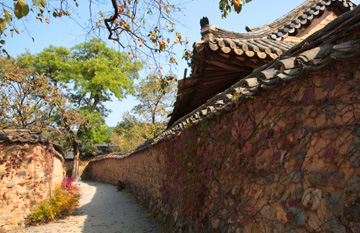
In the Namsa Yedamchon Village, visitors can glimpse the beauty of Korea’s traditional Hanoks over the stone set walls. From the outside, the village signifies old traditional village but from the inside, it projects to the visitors the spirit and the respect of the old scholars.
Namsa Yedam Village is situated at the foot of the Jirisan Mountain. It is the representative traditional Hanok village of Gyeongsang-do alongside Andong Hahoe Village. The village has always been famous to the extent that if one thinks of Gyeongsangnam-do, Sancheong Namsa Village would come to mind. It is well known for being the village of aristocrats and the traditional Hanok village.
In the recent years, where the traditional Hanoks are disappearing faster than ever before, the people in this village live a simple life and try to maintain their traditional homes. The reason why this small village located at the foot of the Jirisan Mountain feels so homely and luxurious as it warmheartedly welcomes the many visitors each day is probably because it still maintains the old spirit and the way of life of our ancestors.
In thousands of years of Korean history, Hanok has deep rooted in the identity of the Korean people and has been changing in style by reflecting the style of life of the people in each era. If the culture of a race is based on a tradition as it takes a step from current to the future, then such changes must always be considered as happening in present tense. The traditional agricultural themed village of Namsa Yedam Village seeks to become the resting ground where people can come to learn how to value the old and preserve such values in the present life time. We hope you will visit Namsa Yedam Village, the learning place for Korea’s traditional culture and where the scenery of the traditional Hanoks are well preserved, and recharge your body and mind while learning about the tradition of Korea.
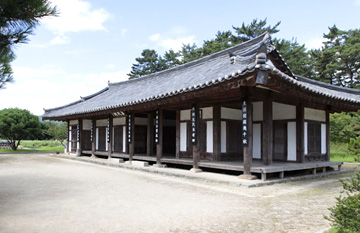
This is the first place to grow cotton in South Korea, and it was all started by a man named Mun Ik-jeom. When he went to Yuan Dynasty in China as an envoy in the 12th year of King Gongmin (1363), he put cottonseed inside of a brush-stand on his way back home and test cultivated the seed with a master craftsman named Jeong Cheon-ik and spread cotton all over the country. In the exhibition hall, you can track the history of cotton, looms, and spinning wheels and also have a look at the process of weaving. Near the cotton farm, people still grow cotton every year to meditate on the spirit of Jasang.
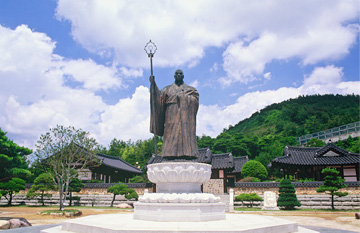
Geoboesa Temple, which means “a temple that transcends time and space”, has Daeungjeon Hall, Seonbang, a pavilion, and Yosachae as annex buildings and there are portraits of the Buddha and the Monk Seongcheol painted by painter Kim So-seok. Geoboesa Temple is a Buddhist sacred ground, a famous place for believers and tourists that allows people to feel the presence of the Monk Seongcheol once again.
At the birth site of the Monk Seongcheol, who remained as the last Zennist to be worshipped and who left this famous Buddhist sermon “Mountains are mountains, rivers are rivers”, his birthplace was restored and Geoboesa Temple was founded. Poyeongdang, which displays his relics, exhibits traditional Korean overcoat that he used to wear, rubber shoes, the books in his possession, and notes and data he used, among others, which allows people to peep into his life.
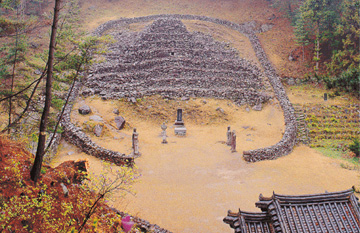
Korea’s only stone royal tomb is known to be the Royal Tomb of King Guhyeong, who was the 10th King of the Gaya. He was also known as Guhae or Yangwang, and was the great-grandfather of Kim Yu-sin. Since becoming the king of Gaya in 521, he reigned for 11 years until 532, when he handed over the land to King Beopheung of Shilla.
There used to be two stories about this tomb. One was that it was a stone pagoda and the other was that it was a royal tomb. The reason why this was viewed as a stone pagoda is that there are similarly shaped stone pagodas in Andong and Uiseong regions. The basis for it being called the royal tomb is that there is a record in the Dongguk yeoji seungnam (Augmented Survey of the Geography of Korea) and in the Saneum-hyeon sancheonjo (Record of Saneum-hyeon). The recording states that 'within the 40 ri’s of mountain in the hyeon, there is a royal tomb piled with stones and all 4 sides are layered and it shall be told to the people that it is the royal tomb of a king.'
The record for stating the name of the king buried in this tomb was first shown in the Wangsan simneunggi written by Hong Ui-yeong, a scholar in the Joseon Dynasty. In addition, there is a temple called the Wangsansa Temple on the west of the tomb and in the Wangsansagi, there is a recording that the person buried in the tomb is King Guhyeong. Unlike general graves, there are 7.15m high stepped stone layers on the middle of inclined hill. When viewing from the front, it is 7 layer stacks and from the back, the tomb utilized the incline so there’s a difference with this tomb and the pyramid type layer built on a flat surface. The top of the tomb is in an oval shape. On the center of the stone tomb, there’s a headstone that says the ‘Royal Tomb of Garak Gukyang’ and on the front, there are stonework but these were put up recently.
During the 17th year of King Jeongjo of Joseon (1793), a wooden case that was passed down from generation to generation in Wangsansa Temple was discovered. Within the case, there were the portraits of King Guhyeong and his Queen, their clothing, a bow, and other objects. To preserve these findings, a royal building called the ‘Deogyangjeon Hall’ was constructed and to this date, a memorial service is held on each spring and autumn of every year. As it is Korea’s only stone tomb, it is recommended that you visit it.
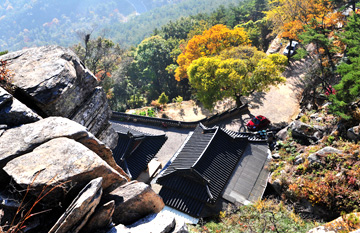
Jeongchwiam Hermitage, situated on the cliff-top of Daeseongsanjeong, is said to have been constructed by the Buddhist Monk Uisang and is famous for the Jeongchwiam Altar Portrait of Buddha.
Jeongchwiam Hermitage, hanging on the rocky cliff, is a temple located between the rocky cliffs of the Daeseongsan Mountain, which is located at the 40 ri on the north of former Danseonghyeon. It has a reputation of having the divinity as vast as that of Geumgang River, and has been known since the old days as Sogeumgang Valley.
On the 6th year of King Sinmun of Shilla, Buddha leaped up from the East Sea and emitted two rays of light. One ray shone on Geumgangsan Mountain and the other shone on Daeseongsan Mountain.
Witnessing the light, the Buddhist Monk Uisang followed these rays and built Wontongam Hermitage in Geumgangsan Mountain and Jeongchwisa Hermitage in Daeseongsan Mountain.
The temple was active during the reign of King Gongmin of Goryeo and closed during the reign of King Hyojong of Joseon. With the construction of Bongseongdang Chihyeon Seonsa, the Gwaneum Statue was formed.
In 1987, Doyeongdang completed the renovation of Wontong and renamed the Daeungjeon Hall and placed Sakyamuni Bonjonbul, Gwanseeumbosal Statue, and Daesejibosal Statue.
In 1995, 16 Nahansang and Altar Portrait of Buddha were placed and in 1996, Sansingak was built and the Altar Portrait of Buddha was placed in the pavilion.
This Altar Portrait of Buddha is designated as Gyeongsangnam-do Cultural Heritage Material 243.
When one looks back on the passage that one took from the edge of the boulder, one will feel like looking down on the world from heaven. The coolness and the calmness will erase all the hardship from the mind and provide a feeling of being free from the troubles of the world.
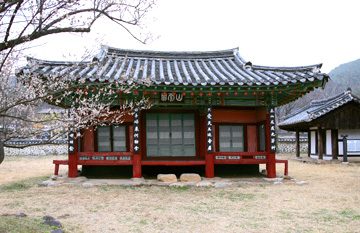
It is the historical site of a famous Confucian scholar Nammyeong Jo Sik, who lived during the mid-Joseon Dynasty period. Jo Sik was offered with numerous official positions but refused to accept any and devoted his life in his studies and fostering future scholars.
The historical site is divided into two sections of Sa-ri, which include Sancheonjae, Byeolmyo, Memorial Stone, and gravestone, and Won-ri, where the Deokcheonseowon Confucian Academy and Sesimjeong Pavilion are built.
The Sancheonjae is the place where he studied and was first constructed in the 16th year of King Myeongjong (1561) and renovated in the 18th year of King Sunjo (1818). Its size is 2 rooms wide and 2 rooms long. Deokcheonseowon Confucian Academy was originally constructed in the 9th year of King Seonjo (1576) with the size of 5 rooms wide and 2 rooms long. The structure standing today was rebuilt in 1926.
Sesimjeong Pavilion was originally built in the 15th year of King Seonjo (1582). The Historic Site of Jo Sik is a nationally designated historic site that includes the Sancheonjae, where the great Confucianism practicing scholar Nammyeong devoted his time in his studies, and Deokcheonseowon Confucian Academy, where his remains were enshrined after his death.
Nammyeong Jo Sik (7th year of King Yeonsangun (1501) ∼ 5th Year of King Seonjo (1572)), had remarkable talents and moderate sentiments and achieved great success as a scholar in his early years but did not take on any official positions and instead devoted all his life in studies and lived a humble life.
When he was 38 years old, he was offered a position of Helleung Chambong and thereafter, was offered a numerous official positions and even number of requests for a meeting by the King but he never accepted any of the positions and only submitted his opinions via petitions and never went to the King. Then in the early October in his 66th year (21st year of King Myeongjong, 1566), he went into the royal palace and met with the King for a brief period and returned back home immediately. After his death, on the 7th year of King Gwanghaegun, he was recognized with a position of Yeonguijeong (chief state councilor) and was given the posthumous title of Munjeong.